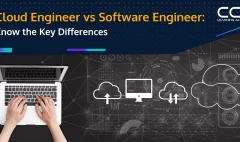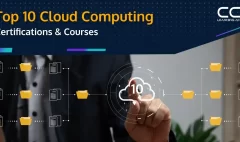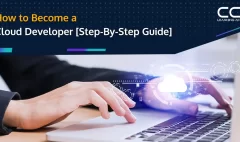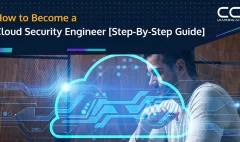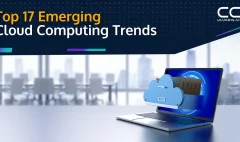Top 30 Cloud Computing Interview Questions and Answers for 2023
Cloud computing has taken off as one of the hottest skills in today’s job market, with the top earners raking in over $150,000 per year. As companies continue to move their operations into the cloud, demand for cloud computing professionals is skyrocketing.
Cloud-based software solutions have become ubiquitous, with 89% of companies hooked on SaaS (Software as a Service). IaaS (Infrastructure as a Service), the fastest-growing segment, is expanding at a CAGR of 33.7%. Cloud computing has won over companies, with 93% giving positive feedback about its security. It has also cut down on human error by 88% and keeps confidential data locked up for 3⁄4 of businesses.
These eye-opening statistics point to the serious demand for cloud computing talent. This article dives into the top 30 cloud computing interview questions that candidates need to be clued up on to land a lucrative cloud computing job.
- Top 30 Cloud Computing Interview Questions and Answers
- 1. What exactly is cloud computing?
- 2. What are the main types of cloud computing service delivery models?
- 3. Sum up the advantages of moving to the cloud.
- 4. Explain cloud computing infrastructure.
- 5. What are the different levels of cloud storage?
- 6. What are microservices, and why do they matter in cloud computing?
- 7. What data types are commonly used in cloud computing?
- 8. How do we create and use Amazon Machine Images (AMIs) for launching EC2 instances?
- 9. Why have Hybrid Clouds grown in importance?
- 10. What are the main deployment types for Cloud Computing? Briefly describe each one.
- 11. What makes up the key pieces of the cloud environment?
- 12. What are the main characteristics of serverless computing in cloud platforms?
- 13. What technologies allow for the development of cloud computing services?
- 14. What exactly is the cloud usage monitor?
- 15. What exactly are applications built for the cloud called?
- 16. What does the term edge computing refer to?
- 17. What does an API Gateway do for APIs?
- 18. How would you lay out security governance when it comes to Cloud Computing?
- 19. Break down the various layers that makeup Cloud Computing architecture.
- 20. What is the complete name and application of ‘Eucalyptus’ in Cloud Computing?
- 21. Can you rattle off the titles of some major cloud vendors and databases?
- 22. What is the difference between cloud data centers and traditional data centers?
- 23. How does Resource Replication take place in Cloud Computing?
- 24. What does Containers as a Service (CaaS) entail?
- 25. What are the foundational components that make up cloud architecture?
- 26. List the 3 fundamental operating clouds in Cloud Computing that get the job done.
- 27. Bring up the different types of data center setups for Cloud Computing.
- 28. What are the applications of APIs in hooking up with cloud services?
- 29. What are some of the major issues that come up with Cloud Computing?
- 30. Explain what is meant by the term encapsulation when referring to cloud computing. How does encapsulating code help developers when building applications for the cloud?
- Conclusion
Top 30 Cloud Computing Interview Questions and Answers
Read on to find out the key cloud computing concepts candidates need to brush up on to ace their next cloud interview. By arming yourself with answers to these commonly asked questions, you’ll be well prepared to ace your next job interview and stand out from the pack.
Equipped with this insider knowledge, you can confidently go into job interviews ready to highlight your skills in this transformational technology. So read on to get a head start on the top cloud computing interview questions for 2023 and launch your cloud computing career to new heights!
1. What exactly is cloud computing?
Cloud computing refers to storing data and accessing programs over the internet instead of on a computer’s hard drive. With cloud computing, information is hosted on remote servers owned by cloud providers, allowing users to log on and access it from any internet-connected device.
Rather than running software and files locally, users can stream them on demand, freeing up their own hardware. Companies can scale services up or down flexibly to accommodate changing needs.
The cloud allows multiple distributed users to hook into shared pools of computing resources, applications, and services as needed rather than maintaining local servers.
2. What are the main types of cloud computing service delivery models?
There are four primary ways that cloud services are provided to customers, known as cloud delivery models.
First, there is Infrastructure as a Service (IaaS), which rents out virtualized computing resources over the Internet. Second, Platform as a Service (PaaS) provides a cloud platform for customers to develop, run, and manage apps without building infrastructure. Software as a Service (SaaS) allows users to access and use cloud-based apps over the internet, removing the need to install software locally. Finally, Function as a Service breaks code into individual functions that run without servers for a serverless architecture.
The four models offer varying levels of control versus convenience for clients when taking advantage of cloud services.
3. Sum up the advantages of moving to the cloud.
Shifting to the cloud allows companies to back up and store data remotely instead of on-site. It provides access to powerful servers to scale compute needs up or down as required.
Cloud solutions increase productivity by allowing employees to access data from anywhere. And cloud services save money by cutting infrastructure costs and speeding up deployments.
4. Explain cloud computing infrastructure.
Cloud computing architecture consists of front-end platforms, back-end platforms, a cloud-based delivery model, and various service models. It works by breaking apart compute resources into discrete services that can scale on demand.
The front-end includes client devices and applications. The back-end provides cloud services like compute power, storage, and networking. Together, they make up a seamless cloud computing system that allows users to access, process, and store data over the internet.
The modular nature of cloud architecture allows flexibility to add or remove components as needed.
5. What are the different levels of cloud storage?
Cloud storage is generally broken down into four main levels – Files, Blocks, Datasets, and Objects.
Files store entire files or documents. Blocks store fixed-size chunks of data that can be grouped together into larger files. Datasets allow storing and analyzing large datasets. Objects store data as individual objects or assets that can be accessed separately. Cloud storage solutions may focus on providing one or more of these levels to meet different data storage and management needs.
6. What are microservices, and why do they matter in cloud computing?
Microservices are small, independent services that make up larger applications. They provide benefits like modular development, flexible scaling, and fault isolation. Microservices play a big role in cloud-native apps because they allow developers to break up monoliths into smaller, independently deployable units. This makes it easier to roll out and update parts of an app.
The cloud’s dynamic resource allocation also caters well to scaling up and down individual microservices based on demand. In short, microservices’ granular and decoupled nature gels well with cloud infrastructure and delivery models.
7. What data types are commonly used in cloud computing?
As the volume of data produced every day increases, cloud computing must support storing many kinds of information like emails, contracts, photos, blogs, and so on. New data types are needed to store new forms of data. For example, to store video files, a streaming video data type was created. The key is picking up new data types to keep pace with and take on the growing piles of data out there.
8. How do we create and use Amazon Machine Images (AMIs) for launching EC2 instances?
We create AMIs by taking snapshots of configured EC2 instances, bundling the snapshots together with launch permissions, and blocking device mappings. AMIs can then be drawn on to launch multiple identical instances, cutting down prep time. By bundling different components into separate AMIs, we can mix and match to spin up varied configurations quickly. AMIs let us replicate and diversify environments without reinventing the wheel each time.
9. Why have Hybrid Clouds grown in importance?
Hybrid Clouds have taken off in popularity because they allow companies to reap the benefits of both public and private cloud models. Organizations can scale up into the public cloud when needed to handle spikes in demand while keeping critical apps and data locked down in a private cloud.
Hybrid Clouds provide the flexibility to seamlessly ramp capacity up and down as business needs ebb and flow. By straddling public and private clouds, organizations gain greater agility and efficiency.
10. What are the main deployment types for Cloud Computing? Briefly describe each one.
There are four main ways to roll out cloud services.
- A private cloud is when a business sets up cloud services on its own servers for internal use.
- A Public cloud is when a third-party provider hosts cloud services externally for customers.
- A community cloud pools resources from organizations with similar needs.
- A hybrid cloud combines private and public cloud services, allowing data and apps to be moved between them.
11. What makes up the key pieces of the cloud environment?
The main parts that make up the cloud ecosystem are cloud users, direct clients, and companies that provide cloud services. These pieces work together and rely on each other to allow the cloud to operate and provide services. The consumers use the applications and platforms that the service providers set up and manage in the cloud. The providers expand their offerings based on demand from consumers. Direct customers act as liaisons between the other two parts.
12. What are the main characteristics of serverless computing in cloud platforms?
Serverless computing allows developers to build and run applications without managing servers. The cloud provider handles provisioning, scaling, and managing servers on demand. Developers just upload code, and the platform takes care of running it.
Serverless architectures break applications into individual functions that run when triggered by events. Resources scale up and down automatically based on usage, so you only pay for compute time used. The provider handles load balancing and fault tolerance behind the scenes.
13. What technologies allow for the development of cloud computing services?
There are a few key areas of technology that have enabled the rise of cloud platforms.
- Broadband networks and web technologies have built up the infrastructure to connect to cloud services.
- Virtualization and multitenant technologies have allowed resources to be efficiently portioned out.
- And data center advancements have beefed up the hardware and facilities required to host cloud platforms.
Together, these developments have brought about modern cloud computing capabilities by constructing the required underlying technologies.
14. What exactly is the cloud usage monitor?
The cloud usage monitor is a tool that allows companies to keep track of and analyze how much they are taking advantage of cloud services. It measures and adds up how much data is being stored in the cloud, what cloud applications are being utilized, how many users are logging into cloud services, and so on.
The goal is to help companies get a handle on their overall cloud usage so they can better manage costs, plan for growth, ensure they are fully capitalizing on the benefits of the cloud, and optimize their investment in cloud services going forward.
15. What exactly are applications built for the cloud called?
Cloud-native applications are designed specifically to run on cloud infrastructure from the ground up. Rather than lifting and shifting legacy applications to the cloud, cloud-native apps are built to take full advantage of cloud computing benefits right out of the box. They are architected to scale up or down on demand and handle distributed computing resources.
Cloud-native apps break up monoliths into microservices that can be updated independently.
16. What does the term edge computing refer to?
Edge computing describes a way of processing data in which computation and data storage are carried out at the periphery or outer limits of the network, near the source of the data, rather than primarily in a centralized data center or cloud.
17. What does an API Gateway do for APIs?
An API Gateway brings multiple APIs together to act as one unified gateway that provides a consistent user experience. It processes each API call reliably. The API Gateway centrally manages the APIs and offers enterprise-level security.
Common API services tasks like statistics, rate limiting, and user authentication can be handled by the API Gateway. It takes on these API jobs, so the APIs don’t have to.
18. How would you lay out security governance when it comes to Cloud Computing?
- Identity management takes on the task of authorizing access to application services in the cloud.
- Access control hands out permissions to users so they can have full control of access over other users entering the cloud environment.
- Authentication and Authorization only allow approved and validated users to take on access to data and applications.
Robust security management comes down to properly authorizing access, handing out the right permissions to users, and only allowing validated users to take on access to critical data and applications in the cloud.
19. Break down the various layers that makeup Cloud Computing architecture.
The cloud is made up of several components that hook together to enable the delivery of computing services:
- The Cloud Controller Layer (CLC) acts as the brain, overseeing and managing the entire cloud infrastructure.
- Walrus plays the role of a data storage service, taking in and holding on to large amounts of data.
- The Cluster Controller doles out tasks and coordinates activity between different clusters of servers.
- The Storage Controller (SC) takes care of monitoring and managing scalable storage in the cloud.
- Node Controllers (NC) carry out monitoring and management tasks at the node level, interacting closely with the physical servers.
Together, these layers join forces and work hand-in-hand to power the backend of cloud computing and drive the delivery of on-demand services to users. The components link up and collaborate behind the scenes to enable the cloud’s flexible and scalable nature.
20. What is the complete name and application of ‘Eucalyptus’ in Cloud Computing?
The complete name of ‘Eucalyptus’ stands for ‘Elastic Utility Computing Architecture for Linking Your Programs to Useful Systems’. Eucalyptus is an open-source software framework in Cloud Computing that allows setting up clusters on the Cloud platform.
It is primarily utilized to build public, hybrid, and private Clouds. It has the ability to turn one’s own data center into a private Cloud; it provides its capabilities to various organizations.
21. Can you rattle off the titles of some major cloud vendors and databases?
- Google Bigtable: This scaled NoSQL wide-column store database service is offered by Google as part of its Google Cloud Platform.
- Amazon SimpleDB: This structured storage web service makes up part of Amazon Web Services’ cloud-based databases. It provides a basic database that takes in structured data sets and spots them into domains.
- Cloud-based SQL (Sequential Query Language): Structured Query Language databases like Microsoft Azure SQL Database, Amazon Relational Database Service (RDS), and Google Cloud SQL are made available on the cloud by huge providers. These databases take on and dish out the common SQL language adapted for cloud infrastructure.
22. What is the difference between cloud data centers and traditional data centers?
Cloud data centers are built and operated by cloud providers like Amazon Web Services, Microsoft Azure, or Google Cloud. They allow companies to rent compute power, storage, and services over the internet rather than setting up their own physical data centers.
Cloud data centers are highly scalable, allowing companies to spin up or scale back resources on demand. They do away with the need for upfront capital expenditures on hardware and reduce the hassle of managing data center infrastructure. Companies pay only for the resources they use.
Traditional data centers, on the other hand, are physical facilities owned and operated by companies themselves. Companies have to invest heavily upfront in servers, storage, networking gear, and real estate. The company is responsible for setting up, monitoring, securing, powering, and cooling the data center. Adding or upgrading capacity requires buying and installing new hardware, which can be time-consuming and disruptive.
Traditional data centers lack the flexibility and scalability of the cloud. However, some companies still operate traditional data centers for applications requiring extremely low latency or for regulatory compliance reasons.
23. How does Resource Replication take place in Cloud Computing?
Resource replication takes place in cloud computing by making copies or duplicates of the same resource across multiple servers or data centers. This is done when a particular resource, such as compute capacity, storage space, or bandwidth, needs to be scaled out to meet increasing demand.
The resource is virtualized, allowing it to be replicated easily and spun up on servers on the fly without having to add new physical hardware. Resource replication enables cloud providers to seamlessly ramp up resources to fulfill spikes in usage while also ensuring services remain available if an outage occurs by shifting traffic to the replicated resources.
24. What does Containers as a Service (CaaS) entail?
CaaS lays out a system that enables developers to run, scale up, manage, upload, and organize containers by utilizing virtualization.
A container bundles up software. It allows teams to scale their apps up to highly available cloud infrastructures. CaaS provides developers with a platform to deploy and operate containers without having to set up the underlying infrastructure. It frees up developers from infrastructure maintenance so they can focus on building applications.
With CaaS, developers can spin up containers on demand and scale them as needed through a self-service portal. The service provider handles provisioning and managing the servers, storage, and networking required to run the containers.
25. What are the foundational components that make up cloud architecture?
The key building blocks of cloud architecture boil down to:
- Reference architecture: This lays out recommended practices for designing cloud-based systems. It spells out guidelines to follow when architecting for the cloud.
- Technical architecture: This digs into the technical elements like compute, storage, and networking that need to be pieced together. It fleshes out the nuts and bolts of implementing a cloud solution.
- Deployment/Operations architecture: This maps out how the cloud system will be deployed, scaled, and operated. It sketches out how the cloud resources will be provisioned and managed.
Getting these cornerstones nailed down is crucial to putting together a solid cloud architecture.
26. List the 3 fundamental operating clouds in Cloud Computing that get the job done.
- Public cloud: This cloud model is owned and operated by third-party service providers that offer computing services like servers and storage over the internet. Public clouds allow customers to scale up or down their usage based on demand.
- Private cloud: This type of cloud is set up solely for a single organization. It is managed and operated by that organization or a third party. Private clouds provide more control over security and infrastructure.
- Hybrid cloud: This cloud environment combines both public and private cloud models. Organizations can determine which applications and data to keep in-house and which ones to host on the public cloud. This provides more flexibility and options to scale resources.
27. Bring up the different types of data center setups for Cloud Computing.
There are a couple main kinds of data center deployments when it comes to Cloud Computing:
- Containerized data centers: Containerized data centers are pre-packaged units that contain servers, network parts, and storage all bundled together and shipped out to large warehouse-style buildings. Here, each rollout tends to be pretty unique.
- Low-density data centers: Containerized data centers promote cramming in high density, which leads to a lot of heat and big engineering issues. Low-density data centers are the fix for this problem. Here, the equipment is spaced out far apart so that it cools down the generated heat.
28. What are the applications of APIs in hooking up with cloud services?
APIs (Application Programming Interfaces) are utilized to get rid of the need to pen down complete programs. Here, instructions are put forward to make communication between one or more applications. The creation of applications is made straightforward and obtainable for the linkup of cloud services with other systems.
APIs help to tie together cloud services with other applications. They allow developers to plug into cloud services without having to build everything from scratch. APIs take care of the nitty-gritty behind-the-scenes communication so developers can focus on building the functionality they need.
29. What are some of the major issues that come up with Cloud Computing?
There are several key problems that crop up with Cloud Computing:
- Security is a huge concern as users give up a lot of control over their data with public Clouds. There is also the risk of the data being seized or taken over.
- Legal and compliance problems can arise as clouds are not tied to geographical boundaries, but services are. This flexibility causes clouds to run into legal and compliance headaches; even though end users are most affected, these issues mainly hit vendors.
- Performance and Quality of Service can suffer and let users down. Optimizing for commercial success on clouds can clash with delivering the promised Quality of Service. If providers fall short of promised QoS, they can tarnish their reputations. Memory and licensing limits can also hamper performance directly by bottling up systems since Software-as-a-Service deals with providing software on virtualized resources.
- Data management poses big hurdles like scaling up data, storing it, shifting it between clouds, and enabling different architectures to access it. Managing data effectively is extremely important as it includes highly sensitive information.
30. Explain what is meant by the term encapsulation when referring to cloud computing. How does encapsulating code help developers when building applications for the cloud?
Encapsulation refers to the process of packaging up software code along with all of its dependencies so that it can run consistently across different cloud environments and on-premises data centers.
By encapsulating the code, developers don’t have to rewrite it based on each individual environment. The dependencies are bundled together with the code so that it can easily be ported from one environment to another without having to reconfigure it. This encapsulation allows developers to focus on the application logic rather than worrying about the underlying infrastructure.
Conclusion
In closing, this article has only scratched the surface of the most common and critical cloud computing interview questions you’re likely to encounter in 2023. Mastering these top 30 questions will put you ahead of the curve and on the path to landing your dream cloud role. However, there is still so much more to uncover about maximizing your cloud skills and becoming a sought-after candidate.
To really level up your cloud abilities, we highly recommend checking out CCS Learning Academy’s in-depth training courses. Their Advanced Architecting on AWS course will take you to the next level on the industry’s top cloud platform. The AZ-304: Microsoft Azure Architect Design eLearning will skill you up on the ins and outs of Microsoft’s robust cloud ecosystem and the AWS Technical Essentials eLearning delivers a thorough grounding across all aspects of AWS.
But don’t stop there! CCS offers an extensive catalog of cutting-edge cloud training with new courses added all the time. Whether you want to drill down on security, DevOps, solutions architecture, or other high-demand cloud skills, they have got you covered. Investing in yourself through CCS’s online education will pay dividends by opening up new career opportunities and elevating your earning potential.
The cloud landscape continues evolving at a breakneck pace. But with the right training and dedication to continuous learning, you can stay ahead of the curve and become the kind of cloud expert that companies are desperate to bring on board. So why wait? Let CCS equip you with the in-demand cloud capabilities to take your career to new heights! Enroll today and secure your future in the exciting world of cloud computing.

